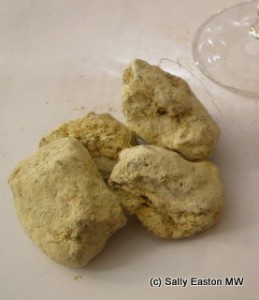Domaine Ogereau

Degraded schist of Bonnes Blanches
Domaine Ogereau is located in the Anjou village of Saint Lambert du Lattay, in the heart of the Coteaux du Layon appellation, nestled into the crook where the small tributary river Hyrome flows north to join the river Layon.
Fourth generation Vincent Ogereau took over the family business in 1989, having worked with his father since graduating in winemaking in 1983. Over the course of those generations the estate has grown to 24 hectares over about 30 different parcels, including two in Savennières. Ninety percent of the vineyard is split equally between chenin blanc and cabernet franc, with the remaining vineyard planted to grolleau, gamay and chardonnay.
Schist underlies all the vineyards in this area. In the Bonnes Blanches vineyard towards the river Layon there are deep, degraded schists which has resulted in a crumbly, white, chalky-textured rock. Nearer the river Hyrome, where the schist is not degraded, it remains a hard, grey rock.
It is the degraded alterite schist of Bonnes Blanches that is good for sweet wines, said Ogereau, “the nature of the earth and the exposure of the terroir can balance out climate extremes. For example, if there is a lot of humidity or rainfall, it is well draining. If it’s dry, the soil is deep and friable so the roots can go deeper to find water.” This, he added, allows the vines to mature earlier, which is good for sweet wines.
He uses a mix of passerillé (slightly raisined on the vine) and botrytis fruit, depending on the wine. Passerillé fruit, which starts developing at the beginning of harvest, from the end of September/beginning of October, Ogereau said, “is citrus, grapefruit, fresh, very sugary and very high acid. You can get up to 30% potential alcohol, and 15 g/l acid (tartaric).” And botrytis fruit, which comes in October/November “has more viscosity, more fat, honeyed, heavy, truly liquoreux. This get up to 20% potential alcohol, and the acidity is lower than passerillé, around 9-10g/l (tartaric).”
On his dry chenin blanc, Vincent is doing his bit to experiment (link to Savennieres) with oak and malolactic fermentation. His Anjou Blanc and Savennières are fermented in 400 to 500 litre oak barrels “not new oak, but recent” he said, “between 1 and 6 years old”. Some of the casks go through malolactic fermentation, which “helps with the unctuousness and fatness of the wine, but I don’t put it all through malo because I like to keep the freshness of chenin blanc.”
Wine tasting, in situ, August 2011
Focused on chenin blanc only.
Domaine Ogereau, Anjou Blanc 2009, En Chenin
Fermentation and maturation, for 12 months, in 400 to 500 litre casks, 1 to 6 years old, on the lees. Dry, 100% chenin blanc.
Toasted vanilla nose, new oak is overt on nose and attack, but doesn’t dominate. Citrus, lemon toast, and a fatness of fresh texture create a rounded, well balanced wine.
Domaine Ogereau, Savennières 2006, Clos le Grand Beaupréau
On schist and sand. 14%. On lees for 15 months.
Beautiful bright deep lemon with green hints. Creamy nose, pale toast, steely core, very smooth texture, with gunsmoke and ripeness. A sophisticated sort of wine, and powerful. It has a good balance of spice and stone fruit, with just a small nudge of alcohol at the end. Smart wine.
Domaine Ogereau, Coteaux du Layon, Saint Lambert, 2009
100g/l RS. Fresh, tropical, and apricot fruits in focused and linear wine. Clear and clean fruit lines.
Domaine Ogereau, Coteaux du Layon St Lambert, Harmonie de Bonnes Blanches, 2009
Liquoreux. A new label in 2009 as Vincent has decided to select best parcels and vintages for the Clos des Bonnes Blanches, which he is only making in the best vintages. This is a mix of passerillé and botrytis fruit. 12%.
Quite a deep gold colour. Honeyed, tropical, dense, viscous. Huge wine, immediate flavours, with a defining acid core, and clear freshness. This has big, sweet, honeyed flavours, with just a hint of the button mushroom of botrytis.
Domaine Ogereau, Coteaux du Layon St Lambert, Clos des Bonnes Blanches, 2007
Not made every year. Not in 2008, or in 2009. Fermentation in 500 litre casks; maturation for 18 months in barrel on lees. 200g/l RS.
Deep gold colour. Nose is dense and golden with nectar-like honeyed, tropical, lush sweetness, that is fresh and cleansing. Huge fruit and concentration, with tangerine notes and zest coming through its many layers. Long and delicious. Vg.
My research visit to the Loire in August 2011 was sponsored by InterLoire.



